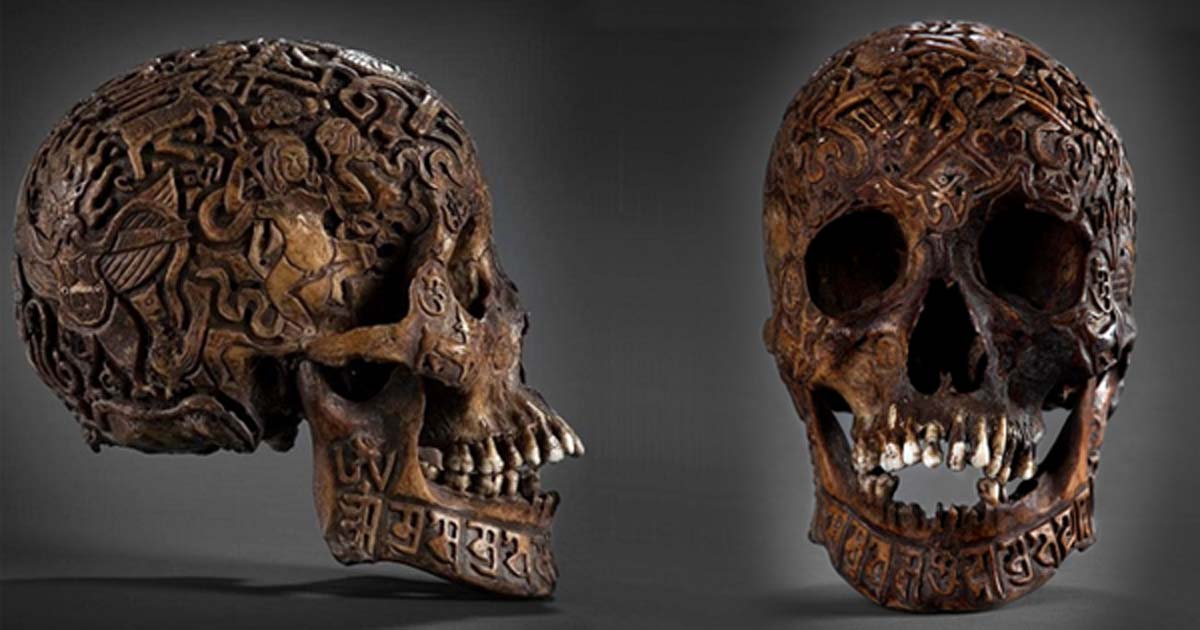
Experts from a wide array of organizations are examining an intricately carved skull discovered in an antique shop in Vienna in 2011. The skull, believed to be 300 years old, is completely covered with figures and symbols that seem to hold some sort of religious significance. Yet nobody is able to determine what that significance is, let alone who carved the skull, or the identity of the person to whom the skull once belonged.
Bits and Pieces about the Carved Skull’s Owners
The shopkeeper has said that the skull was sold to him by a man who said it belonged to one of his ancestors, a medical doctor who had traveled extensively throughout Asia. Once, he was able to provide medical assistance to an abbot in a Buddhist monastery in Tibet. In gratitude for his services, the abbot gave the doctor a number of relics, including the skull.

A little monastery in Tibet. (Antoine Taveneaux/CC BY SA 3.0) It is said that an abbot in a Buddhist monastery gave a doctor the carved skull for providing medical assistance.
In August 2011, the new owner of the skull posted photos of it on the website forum ‘Asian Arts.’ He wrote:
“I got this skull in March 2011 from an antique shop in Vienna, Austria. Showed it to several experts and organizations, such as the Institute for Tibetan and Buddhistic Studies in Vienna, the Museum of Natural History Vienna, and the Völkerkunde Museum. The Tibetan letters and most of the symbols got deciphered, but no one ever heard of a skull like that. Except one Tibetan Khenpo (Monk-Professor), who said such skulls were carved a long time ago to take a curse off a family or to guide the soul of a mislead human being on the right path.” (Klemens, 2011)
The Letters and Images Carved on the Skull
Further information about the practices that the Monk-Professor alluded to is incredibly limited. The letters carved into the skull’s jaw could be a Devanagari script that read “Om, Ma, Sa, Ma, Ta, Sa, Om, Da, Ma, Ta.” Others maintain that the writing is an example of the ancient script called lant’sa or the 7th-century Indian script ranja. Without definitively knowing the skull’s origin, it may be impossible to translate the letters.

Front view of the carved skull. (Klemens)
The images carved into the skull provide deeper insight. The two figures featured prominently on the top of the skull are Citipati, protective deities in some Buddhist traditions. Usually, one is male and one is female, but that cannot necessarily be discerned from this skull. Citipati are lords of the underworld and are traditionally depicted dancing wildly, the eternal dance of death.
Klemens, writing later on the same Asian Art Forum, commented with some new information he had gleaned from one of the experts he wrote to: “I was told they are depicted in the “bow and arrow”-posture, which is referring to the highest grade of the outer tantra” (Klemens, 2011).

Top view of the carved skull showing Citipati. (Klemens)
Another figure, the bird-like creature on one side of the skull, is believed to be Garuda, a deity in Hindu and Buddhist traditions. Garuda is usually depicted as being part man, part eagle. He is the sworn enemy of the Nagas, a demon serpent race. Like an eagle, Garuda swoops down and snatches Nagas in his talons. On the skull, there are several squiggly lines that could be snake-demons and it definitely looks like there is one in the clutches of the bird-like creature on the side of the skull.

Garuda on the carved skull. (Klemens)
On the opposite side is a figure of Vajrapani, an ancient protector who is believed to have worked with Gautama Buddha. Vajrapani actually is part of a trio, the other two of which are not believed to be represented here. The first is Avalokitesvara, who represents the infinite compassion of all the buddhas, and the second is Manjusri, who represents the infinite wisdom of all the buddhas. Vajrapani represents the infinite power of the buddhas. There is also a female figure that has yet to be identified.

A figure of Vajrapani on the carved skull. (Klemens)
Finally, the space between these figures is full of Om symbols and animals that could be goats, snakes, squirrels, an elephant head, and birds. Each of these could have a unique meaning or they could collectively hold some significance.
The Carved Skull is a Rare Artifact
As one can see, little is known about this skull. Unfortunately, its private ownership limits the ability of experts and academics to study it. While carved skulls are not unheard of, they are exceedingly rare. And one created with this level of skill and religious meaning is certainly a treasure.

Front view of the mysterious carved skull. (Klemens)
Top Image: A side and front view of the mysterious carved skull. Source: Klemens
By Kerry Sullivan